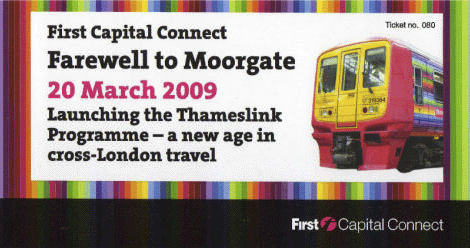|
Notes: The sub-surface part of Moorgate Street station was opened by the Metropolitan Railway in December 1865 as the first extension from its original route between Paddington and Farringdon, the Widened Lines following in 1868. The station was renamed Moorgate in 1924. Moorgate Station was closed on 16th October 1940 when the service over the Widened Lines was temporarily withdrawn due to enemy action Moorgate station suffered considerable bomb damage both in 1940 and 1941 and the service wasn't reinstated until 1946. The station was completely rebuilt and extended to six platforms in the 1960's.
 |
In recent years peak-hour First Capital Connect trains on the Thameslink service from Bedford and Luton terminated at platforms 5 & 6, parallel to the Circle, Hammersmith & City and Metropolitan platforms 1 & 2 (through platforms) and 3 & 4 (bay platforms). The Underground lines are electrified on the standard London Underground four rail system, the Thameslink |
bays used 25 kV AC overhead. The word Thameslink does not appear on any signs within the station; signs to platforms 5 & 6 bear the words 'Trains to Bedford'.
Under the new Thameslink Programme the platforms at Farringdon will be extended at the southern end of the station to accommodate 12 carriage trains. The proximity of Farringdon Junction to the station itself means that the extended platforms will be over the junction. As a consequence, the junction will be removed, leaving only the route through the Snow Hill tunnel, to accommodate this the line to Moorgate (including platforms at Barbican) closed on 20 March 2009. However, the platforms currently remain in use as a turnaround for First Capital Connect services that are starting and terminating at Farringdon and as a stable for extra trains during times of service disruption, until the work to extend Farringdon's platforms begins in late 2009.
| The British Rail services to Moorgate along this route were originally steam operated, then operated by Cravens-built diesel multiple units and class 31s hauling non-corridor stock, until the mid 1970's. Services went to both London Midland Region (LMR) destinations (along the Midland Main Line) and to Eastern Region (ER) destinations (via the York |
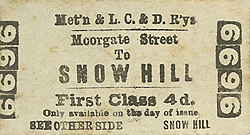 |
Road Curve/Hotel Curve to join the East Coast Main Line (ECML) at King's Cross). The LMR trains along the Midland Main Line were withdrawn circa 1979, but the line was electrified and reopened around 1983. The ECML connections were removed when the deep level line transferred to British Rail and became the sole route for ER trains. All four bay platforms may have been used by British Rail services until this time.
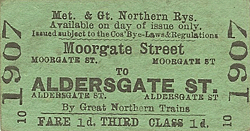 |
The last scheduled departure from Moorgate was at 19.06 on 20th March, with a final train arriving at Moorgate at 7:41pm this would then run empty back to its depot at Cricklewood at 19.54. After persuasion from UK Railtours, First Capital Connect agreed on the morning of closure to run this last train as a special service for enthusiasts and anyone who |
wanted to say goodbye to the line leaving little time for advance publicity.
The company didn't charge for travelling on this train although passengers did require a platform ticket (now £1!) to get on to the station. They gave away free commemorative tickets asking for a donation to the Railway Children charity. First Capital provided a 'countdown to closure clock' at the end of Platform 5 & 6 and a number of staff were on hand including Chief Executive Elaine Holt who posed for photographs in front of the special 'last train' which was fitted with a commemorative headboard back and front.
There were a large number of railway enthusiasts present, most of them travelling on the last train which was a special train repainted to promote the Thameslink Programme.
BRIEF HISTORY OF THE WIDENED LINES
The Metropolitan Railway as it was now known was opened on 10 January 1863 and was worked by the GWR. The line was an immediate success although relations between the Metropolitan and the GWR were not good and the GWR gave notice that they would cease to work the line after 30th September. To counter this, the Metropolitan obtained rolling stock from the Great Northern Railway until their own rolling stock was delivered with the trains coming down the newly completed King's Cross connection.
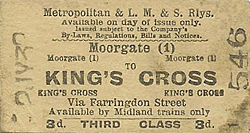 |
The overall success of the Metropolitan was so immediate that the idea of a circular line connecting City and West End rapidly developed. The first extension of the Metropolitan was of 0.75 mile to the more convenient Moorgate Street station opened on 23 December 1865.The circular line, invariably known as the Inner Circle, was beginning to take |
shape and was completed by 1875.
The connection with the GNR at Kings Cross which came into regular use on 1st October 1863 consisted of two single line tunnels with east and west facing connections a junction with the LCDR with a twin line connection to the Midland Railway at St. Pancras. A further connection to the south from Farringdon through Snow Hill tunnel was opened on 1st January 1866 and a triangular layout, under Smithfield Market, was completed by a spur from Aldersgate Street to the LCDR which opened on 1st September 1871 forming the only north-south route across the City
 |
Both passenger and freight traffic was heavy and it was soon clear that the double track of the Metropolitan would be insufficient. A second pair of tracks, always known as the Widened Lines, was therefore provided by that company between King's Cross and Moorgate Street opening between Farringdon Street and Aldersgate Street on 1st March 1866, being extended to Moorgate Street on 1st July and westward to King's Cross on 27 January 1868 for goods and 17 February for passengers.
Joint stations with platforms on both the Metropolitan and the Widened lines were provided at Moorgate Street, Aldersgate Street, Farringdon Street and Kings Cross. Mixed-gauge was at first provided on the Widened Lines, but it is unclear if the King's Cross - Farringdon Street section was ever used by GWR broad-gauge trains. Goods stations were opened by |
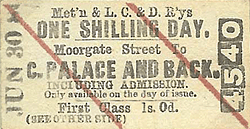 |
the GNR at Farringdon (closed 16 January 1956) and by the Midland at Whitecross Street (closed 1st March 1936).
In the 1880's there were about 200 trains a day over the Widened Lines into Moorgate Street and 100 southbound through Snow Hill Tunnel but by the turn of the century passenger traffic over the widened Lines was in decline. By 1901 the City & South London Tube was operating through the City, while the new motor-buses and the Kingsway tram tunnel were soon to speed up road journeys.
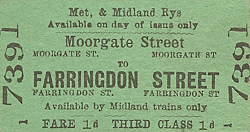 |
The GN/SE & CR service ceased from 1st October 1907 and its Midland counterpart from 1 July 1908. SE & CR trains continued to use Moorgate until 1st April 1916, after which the Aldersgate curve was abandoned and the north-south passenger link over the Widened Lines severed as an economy measure during WW1.The City services of the GNR and |
Midland also suffered, partly from northward extensions of the City & South London, but mainly from the Great Northern & City Tube, which diverted GNR passengers at Finsbury Park and from trams.
| After the First World War trains ran in peak hours only. The Metropolitan Railway however continued to flourish however and in 1935 there was a proposal to relocate their platforms at Kings Cross 400 yards to the east to make a more convenient interchange with the deep tube stations on the Northern and Piccadilly line. Before this could be completed the route to |
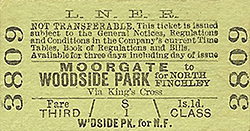 |
Moorgate had to be closed on 16th October 1940 due to enemy action during WW2. The service over the Widened Lines from Moorgate to the Great Northern and Midland lines was reinstated in 1946.
By now the widened lines carried very little passenger traffic. Although passenger trains through Snow Hill tunnel had ceased in 1916 the tunnel was still a vital north-south freight link with some 90 trains a day in 1962, but all regular freight and parcels services were withdrawn in 1969 and the route was finally abandoned in 1971 and the track was lifted.
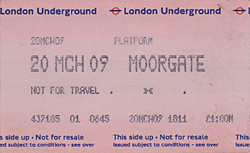 |
The closure was however to be short lived, in 1978 work started on rejuvenating the Widened Lines as part of a new north - south route that would eventually link Brighton to Bedford. Initially the stations and Moorgate, Aldersgate, Farringdon and Kings Cross were closed and the track was lifted during the refurbishment. On 15th July 1983 the northern section of the line came into use between Bedford and London |
St. Pancras and then over the old widened lines to Moorgate, this was nicknamed the 'Bedpan Line'. On reopening Kings Cross Station was renamed Kings Cross Midland City; from the south, services still terminated at Holborn Viaduct.
In May 1988 Snow Hill tunnel was reopened to passengers with the inauguration of the Thameslink service and at this time Kings Cross Midland City was renamed Kings Cross Thameslink
Source: A regional history of the Railways of Great Britain Vol 3 - Greater London by H.P.White. David & Charles 1971 ISBN 0 7153 5337 3. Ticket from Michael Stewart
See also Kings Cross Thameslink and Kings Cross York Road |

old1.jpg)

old3.jpg)
old2.jpg)
old5.jpg)
old6.jpg)
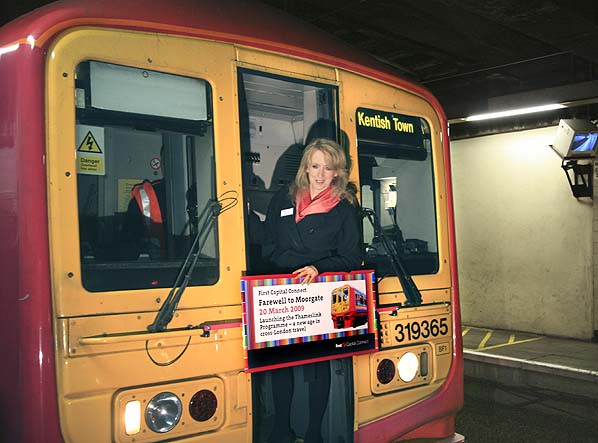
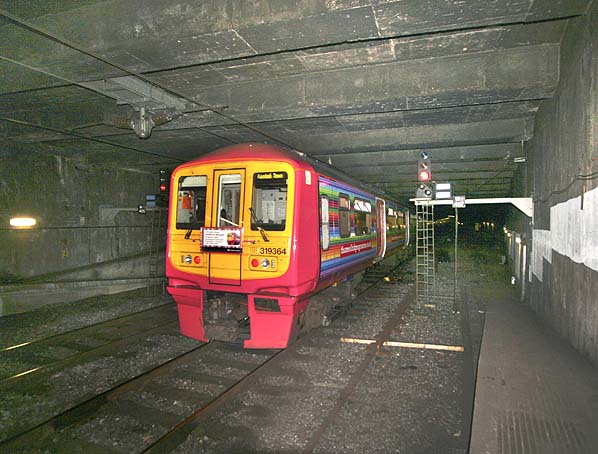
 Home Page
Home Page 


